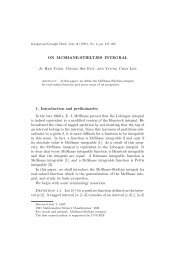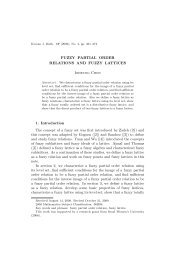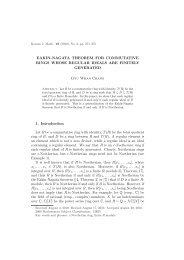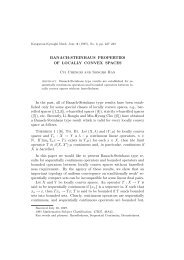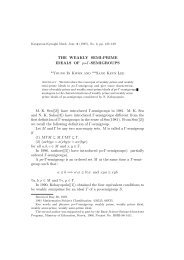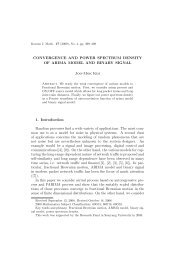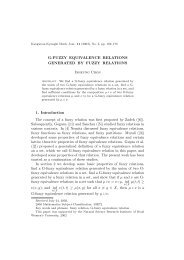ϵ-FUZZY EQUIVALENCE RELATIONS Inheung Chon 1 ...
ϵ-FUZZY EQUIVALENCE RELATIONS Inheung Chon 1 ...
ϵ-FUZZY EQUIVALENCE RELATIONS Inheung Chon 1 ...
You also want an ePaper? Increase the reach of your titles
YUMPU automatically turns print PDFs into web optimized ePapers that Google loves.
74 <strong>Inheung</strong> <strong>Chon</strong>Proof. It is clear that µ ∩ ν is ɛ-reflexive and symmetric. ByProposition 2.7, [(µ ∩ ν) ◦ (µ ∩ ν)] ⊆ [µ ◦ (µ ∩ ν)] ∩ [ν ◦ (µ ∩ ν)] ⊆[(µ◦µ)∩(µ◦ν)]∩[(ν◦µ)∩(ν◦ν)] ⊆ [µ∩(µ◦ν)]∩[(ν◦µ)∩ν] ⊆ µ∩ν. Thatis, µ ∩ ν is transitive. Thus µ ∩ ν is an ɛ-fuzzy equivalence relation. □It is easy to see that even though µ and ν are ɛ-fuzzy equivalencerelations, µ ∪ ν is not necessarily an ɛ-fuzzy equivalence relation. Wefind the ɛ-fuzzy equivalence relation generated by µ ∪ ν on a set in thefollowing proposition.Proposition 3.2. Let µ and ν be ɛ-fuzzy equivalence relationson a set S. Then the ɛ-fuzzy equivalence relation generated by µ ∪ νin S is ∪ ∞ n=1(µ ∪ ν) n = (µ ∪ ν) ∪ [(µ ∪ ν) ◦ (µ ∪ ν)] ∪ . . . .Proof. Clearly (µ∪ν)(x, x) ≥ ɛ > 0. That is, µ∪ν is ɛ-reflexive. ByProposition 2.6, ∪ ∞ n=1(µ∪ν) n is ɛ-reflexive. Clearly µ∪ν is symmetric.By Proposition 2.5, ∪ ∞ n=1(µ ∪ ν) n is symmetric. By Proposition 2.4,∪ ∞ n=1(µ∪ν) n is transitive. Hence ∪ ∞ n=1(µ∪ν) n is an ɛ-fuzzy equivalencerelation containing µ ∪ ν. Let λ be an ɛ-fuzzy equivalence relation in Scontaining µ ∪ ν. Then ∪ ∞ n=1(µ ∪ ν) n ⊆ ∪ ∞ n=1λ n = λ ∪ (λ ◦ λ) ∪ (λ ◦ λ ◦λ) ∪ · · · ⊆ λ ∪ λ ∪ · · · = λ. Thus ∪ ∞ n=1(µ ∪ ν) n is the ɛ-fuzzy equivalencerelation generated by µ ∪ ν.□Theorem 3.3. Let µ and ν be ɛ-fuzzy equivalence relations on aset S such that µ(x, x) ≥ ν(x, y) and ν(y, y) ≥ µ(x, y) for all x, y ∈ S.If µ ◦ ν = ν ◦ µ, then µ ◦ ν is the ɛ-fuzzy equivalence relation on Sgenerated by µ ∪ ν.Proof.(µ◦ν)(x, x) = sup min [µ(x, z), ν(z, x)] ≥ min (µ(x, x), ν(x, x)) ≥ ɛ > 0z∈Sfor all x ∈ S. That is, µ ◦ ν is ɛ-reflexive. Since µ and ν are symmetric,(µ ◦ ν) −1 = ν −1 ◦ µ −1 = ν ◦ µ = µ ◦ ν. Thus µ ◦ ν issymmetric. Since µ and ν are transitive and the operation ◦ is associative,(µ ◦ ν) ◦ (µ ◦ ν) = µ ◦ (ν ◦ µ) ◦ ν = µ ◦ (µ ◦ ν) ◦ ν =(µ ◦ µ) ◦ (ν ◦ ν) ⊆ µ ◦ ν. Hence µ ◦ ν is an ɛ-fuzzy equivalence relation.Since ν(y, y) ≥ µ(x, y), (µ ◦ ν)(x, y) = sup min[µ(x, z), ν(z, y)] ≥z∈Smin(µ(x, y), ν(y, y)) = µ(x, y). Since µ(x, x) ≥ ν(x, y), (µ ◦ ν)(x, y) =supz∈Smin [µ(x, z), ν(z, y)] ≥ min (µ(x, x), ν(x, y)) = ν(x, y).Thus


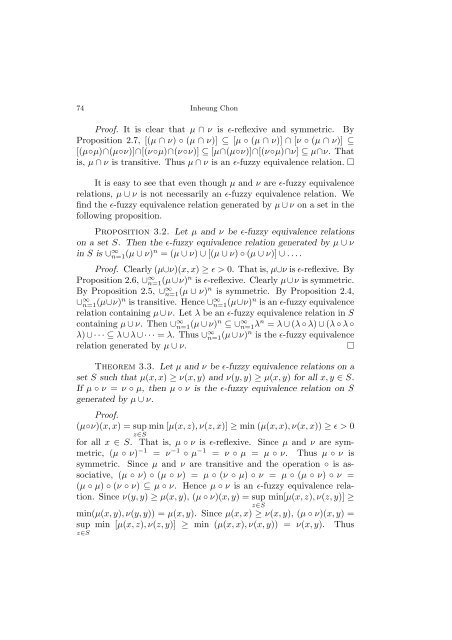
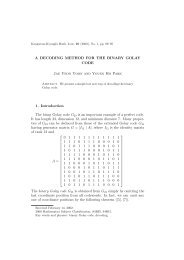
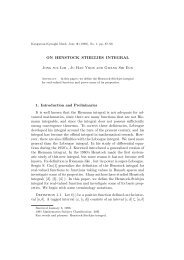
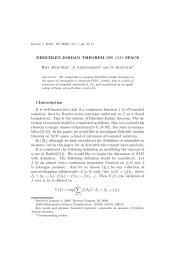

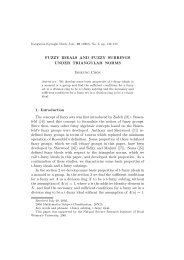
![SEMI-REGULAR po-SEMIGROUPS SK Lee J. Calais([1])](https://img.yumpu.com/46211509/1/184x260/semi-regular-po-semigroups-sk-lee-j-calais1.jpg?quality=85)
